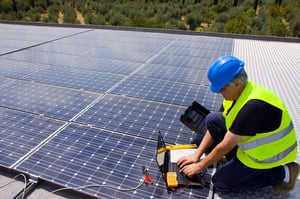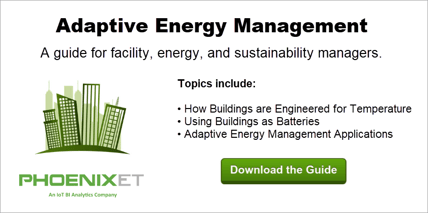Share this
4 Common Myths of Energy Conservation in Building Management
by Phoenix Energy Technologies on Jul 10, 2019
 This post is part of The Guide to Building Management Technologies.
This post is part of The Guide to Building Management Technologies.
Under constant pressure to increase comfort and efficiency, reduce energy waste and corporate carbon footprints, Facility Managers today can easily find themselves bogged down in the swamp of myths surrounding the concept of energy conservation in building management. Today we will debunk four of the most common misconceptions of energy management that are costing businesses money.
Myth One: Unoccupied Space Should Be Powered Down
It is commonly believed that powering down cooling systems overnight and on weekends when the building, or sections of the building, are unused will decrease energy use and save money.
TRUTH: You will use more energy- and, conversely, spend more money- to repeatedly cool a space up and down than you will if you maintain a reasonable “set-back” temperature during unoccupied periods (typically no more than 4 degrees).
A building's HVAC system is broken into zones that are designed to cool a specific area within a certain time frame; typically, at a rate of no more than 2º per hour, per zone. That means that by increasing the unoccupied cooling setpoint temperature by 10ºF (72ºF to 82ºF) during unoccupied periods, it can take up to five hours of constant energy use to restore the building to the preferred daytime temperature.
When a building's cooling system is set at 72ºF, the HVAC system will automatically engage each time the temperature begins to fluctuate higher than that setpoint (plus a small “dead band”...more about this later), disengaging when it is back at the desired setting. This minimizes the amount of energy needed to maintain the desired temperature.
Consider a building's energy use the same way that you would your car's mileage on a road trip. You wouldn't expect the car to get the 55 MPG highway mileage in stop-and-go traffic? In the same way, a building's cooling system can't operate optimally when it is constantly trying to offset unnecessary heat influxes.
Myth Two: Focusing on energy savings will save money.
Stop trying to save energy and save energy!
TRUTH: You will save more money by maximizing the energy used rather than trying to use absolutely as little energy as possible. In fact, this is the definition of efficiency; getting the maximum amount of work done using the optimal amount of energy.
By integrating an Adaptive Energy Management (AEM) system into your building, you can automate building functions, manage machine settings, and reduce costs by making the best possible use of the energy that you are already paying for.
Myth Three: You Must Sacrifice Comfort to Save Energy.
It is not an either-or situation.
TRUTH: Current adaptive technology can maximize your building's energy usage without sacrificing your customers' or employees' comfort.
Harking back to Myth Number One, it has been proven that maintaining a comfortable HVAC setpoint is your best bet for energy conservation, but did you know that it also increase sales and employee satisfaction?
According to a study cited by the Association for Consumer Research, "..store environment can have substantial lagged effects on shopping behaviors, particularly consumers' patronage behaviors", and, according to a study by the Lawrence Berkeley National Laboratory, "…performance decrements are more clearly established for temperatures outside of the comfort zone".
In other words, not only do you not have to sacrifice comfort for conservation, proper environmental control will actually increase sales and improve employee productivity.
Download our Adaptive Energy Management Guide
Myth Four: Building Controls and Monitors are Accurate.
This one surprises a lot of people. Many facility managers mistakenly believe they don’t need to optimize their control systems because their building controls are already accurate. Remember the aforementioned “dead band”.
TRUTH: Most traditional building controls have a significant error range.
This error range is called in the industry a “dead band”. “Dead” because the control system shuts off prematurely in anticipation of reaching the set-point (as a matter of fact this is what the temperature “anticipator” circuit does in your home thermostat!).
Most commercial building systems are installed long before the interior finish work is completed, leaving temperature sensors unable to:
- Get an accurate reading
- Adjust for solar heat gain in a southern facing office
- Minimize airflow
- Dehumidify equipment
The above and a host of other external variables all come into play when set-points are configured in each particular space. Without the integration of a smart system, such as an Adaptive Energy Management system, it is nearly impossible to ensure that the building controls are performing as expected. In fact, comfort (hot and cold calls) is the number one complaint from occupants in a building, by far.
Whether your business is centered in grocery, retail, education, entertainment, or healthcare, Phoenix Energy Technologies has powerful tools to maximize comfort and efficiency, reduce energy waste and your carbon footprint.
To learn more about the different ways that you can lower your building's energy consumption and maximize your current energy use, contact us today.
Related Posts
What Facility Managers Need to Know About Load Shifting - Part 1
Are You Managing Your Energy Spend?
Precision Building Management: Understanding Closed Loop Control
Share this
- Facilities Management (91)
- Energy Management (69)
- Company News (49)
- Smart Buildings (37)
- Retail (36)
- Building Management (24)
- Building Automation Systems (21)
- Sustainability (20)
- Energy Demand Management (19)
- EEI (15)
- Adaptive Energy Management (14)
- Grocery (14)
- demand response (14)
- Artificial Intelligence (12)
- Data Integration and Visibility (10)
- HVAC IQ (9)
- COVID-19 (8)
- Customer Spotlight (8)
- Carbon Management (7)
- Setpoints and Temperatures (7)
- Equipment Maintenance (6)
- Operational Efficiency (6)
- Refrigeration Optimization (6)
- Ask Ron (5)
- Asset Manager (5)
- Finance and Procurement (5)
- IoT and Digital Transformation (5)
- Awards (4)
- Comfort (4)
- Energy & Store Development (4)
- Safety and Compliance (4)
- Demand Charge Management (3)
- Energy Management System (3)
- Lifecycle Asset Management (3)
- Premium Services (3)
- Refrigeration IQ (3)
- Automated Demand Response (2)
- ConnexFM (2)
- Customer Service (2)
- HVAC Vendor Management (2)
- Load Shedding (2)
- Technician View (2)
- AIM Act (1)
- ALD (1)
- Analytics (1)
- Data (1)
- Data Integration and Visualization (1)
- EMS (1)
- Knowledge Center (1)
- OSHA (1)
- asset management (1)
- December 2025 (1)
- November 2025 (1)
- October 2025 (2)
- September 2025 (1)
- August 2025 (3)
- July 2025 (1)
- June 2025 (1)
- May 2025 (2)
- March 2025 (2)
- February 2025 (1)
- January 2025 (2)
- December 2024 (2)
- October 2024 (1)
- September 2024 (1)
- August 2024 (2)
- June 2024 (2)
- April 2024 (2)
- March 2024 (2)
- January 2024 (1)
- December 2023 (1)
- October 2023 (2)
- September 2023 (2)
- August 2023 (2)
- July 2023 (1)
- May 2023 (2)
- April 2023 (2)
- March 2023 (3)
- February 2023 (1)
- January 2023 (1)
- December 2022 (1)
- November 2022 (2)
- October 2022 (2)
- September 2022 (1)
- May 2022 (2)
- April 2022 (1)
- March 2022 (3)
- February 2022 (2)
- January 2022 (4)
- December 2021 (2)
- November 2021 (3)
- October 2021 (1)
- September 2021 (3)
- August 2021 (4)
- July 2021 (1)
- June 2021 (2)
- May 2021 (1)
- January 2021 (2)
- December 2020 (2)
- November 2020 (2)
- October 2020 (3)
- September 2020 (4)
- August 2020 (3)
- July 2020 (2)
- June 2020 (3)
- May 2020 (3)
- April 2020 (5)
- March 2020 (5)
- February 2020 (4)
- January 2020 (4)
- December 2019 (4)
- November 2019 (3)
- October 2019 (4)
- September 2019 (5)
- August 2019 (4)
- July 2019 (4)
- May 2019 (2)
- April 2019 (3)
- February 2019 (1)
- December 2018 (1)
- November 2018 (1)
- October 2018 (3)
- September 2018 (3)
- August 2018 (3)
- July 2018 (3)
- June 2018 (3)
- May 2018 (1)
- June 2015 (1)
- March 2013 (1)
- January 2013 (1)
- December 2011 (1)
- October 2011 (1)
- September 2011 (1)



